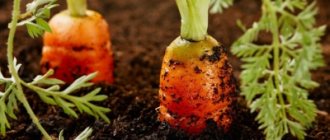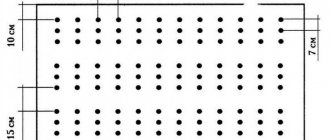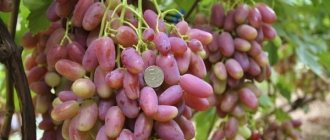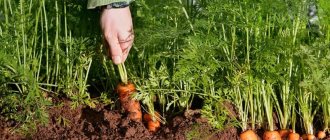“Canada” is one of the best varieties of carrots, widely cultivated by gardeners in our country. The variety combines excellent taste, high yield and rapid adaptability to any climatic conditions. Let's find out how to plant these carrots correctly, how to grow them and preserve the harvest.
Carrot Canada
Carrot seeds Canada
The Canada carrot variety has good yields
Description of the variety
“Canada” is a mid-late ripening hybrid variety characterized by good yield and excellent taste. Designed for growing on heavy clay soils.
Roots
Carrots are of a standard shape, in the form of an elongated cylinder, the tips are slightly rounded, the diameter of the root crop is 5 cm, the length is 20 cm. The mass is large, on average 0.1-0.2 kg, there are also specimens weighing 0.5 kg. The flesh is deep orange, the center is almost the same shade, but slightly darker.
The peel is orange, without tubercles, smooth to the touch. The leaves of the plant are dark green, collected in a semi-spreading strong rosette.
Seeds
The seeds are small and do not have very good germination. Fraction 1.7–2.0 mm. It’s not difficult to purchase them - they are available in every city in our country. It will not be possible to collect seed material on your own, since Canada carrots are a hybrid variety. Seeds from hybrid varieties do not retain the genetic properties of their “parents,” and “Canada” carrots are no exception.
Advantages and disadvantages
The “Canada” variety, like other crops, has pros and cons; they must be taken into account when choosing this plant.
Advantages of this variety:
- low maintenance requirements;
- has no special preferences in the choice of soil;
- excellent taste of root vegetables;
- good shelf life under proper storage conditions;
- high productivity;
- industrial volumes of crops can be harvested by machine;
- high content of vitamins and minerals in root vegetables;
- resistance to many typical carrot diseases;
- the presence of large amounts of beta-carotene in root vegetables.
Disadvantages of this variety:
- has a negative attitude towards waterlogging of the soil;
- takes a long time to germinate;
- affected by carrot fly;
- seeds for sowing must be purchased annually, since Canada is a hybrid variety.
History of carrots
The history of carrots as an agricultural crop goes back more than 3 thousand years. It grew in Afghanistan and had a purple fruit with a sharp, bitter taste. Only seeds and leaves were used as spices. Even in the 12th century, the carrot fruit was used as horse feed. Only in the 16th century, thanks to the Dutch, the familiar orange vegetables appeared.
In the Middle Ages, carrots were considered a delicacy for gnomes, and people believed that gnomes paid for a certain amount of these vegetables in gold bars.
Recently, thanks to the work of the Dutch, a new hybrid variety Canada f1 (Canada), a carrot with high quality and taste, has appeared.
Landing Features
Carrot seed takes a very long time to germinate, so the grains need to be sown as early as possible. You should not make the crops too dense; the best planting frequency is approximately 100 seeds per 1 square meter. m.
Lighting and soil requirements
Carrots of this variety are neutral to light, so if there is not enough light, the variety can easily survive it. The plant grows on various soils, but it is better to plant this carrot on slightly acidic sandy or light loamy soils.
The variety also produces good results on dense chernozems; it is also permissible to grow on clay soils, where other varieties of the crop do not grow at all.
“Canada” cannot be planted in freshly manured soil.
Optimal timing
As mentioned earlier, sowing must be done as early as possible. It is better to do this in the last week of April or early May, but not later. Sowing before winter is carried out in mid-October - early November, the temperature by this time should drop to +5 degrees.
Site selection and soil preparation
The “Canada” hybrid can withstand a lack of light, so the variety can be planted anywhere on the site, even in the darkest. As for preparing the soil, it all depends on the choice of soil in which you plan to plant carrots. The best option is light soils, where carrots produce the greatest yield. Dig up the soil in advance, especially if it is heavy, and feed it with mineral fertilizers.
Crop rotation rules
When growing any crop, crop rotation plays an important role. It is better to plant carrots after cabbage, tomatoes, potatoes, lettuce or onions. This variety should not be sown after cilantro, celery, parsley or caraway.
Sowing technology
Sowing carrots is not very difficult, but there are certain requirements that must be observed during sowing. The germination rate of the seeds is not particularly high, but if you place them in the ground without preliminary preparation, this period will drag on for another 1-2 weeks. Dry grains cannot be planted, as they contain a huge amount of beneficial oils, which do not allow water supplied during irrigation to reach the embryo.
Before direct planting, the seed must first be washed well and then soaked. As a soaking agent, use 1 liter of warm water and a little stimulating solution, for example “Effekton”. It can be replaced with sodium humanate or 1 tbsp. l. wood ash.
Place the seed in this product, placed in a fabric bag. After a day, take it out and rinse with water, wrap it in gauze and put it in the refrigerator for 3 days - to strengthen the immune system.
Before sowing, take out the bag and dry the grains until they become free-flowing.
Algorithm for sowing carrot seeds:
- Moisten the soil and use a hoe to make small indentations in it.
- Place seed into the holes to a depth of 15-20 mm.
- Sowing pattern: seeds - 50 cm from each other, furrows - 20-30 cm.
- After sowing, carefully mulch the beds with peat.
- Before the first shoots form, cover the beds with covering material. Agrofibre is ideal.
Growing and caring for carrots
Despite the unique ability of Canada carrots to adapt to any growing conditions, the plant still needs high-quality and regular care. It consists of watering and loosening the soil, thinning the plantings and applying fertilizing.
Watering
Carrots “Canada” are considered a resistant variety, so they react calmly to differences in water volumes. But do not overdo it with watering, otherwise the root crops will begin to rot and there will be no harvest. In addition, frequent application of moisture negatively affects the density of the soil, so water the seedlings as needed.
Thinning
Thinning is a very labor-intensive process, so not every summer resident likes to do it. Without thinning, carrots will grow small and not as juicy as they should be. Shoots appear 14-20 days after planting; it is during this period that thinning should be done. Between the rows, weed out the weeds and loosen the soil; it should become airy and light. Such an event will help carrots grow better and bring as much harvest as possible.
Fertilizer application
Never apply organic fertilizers between the rows of carrots; they will completely burn the sprouts. Choose mineral fertilizers. Use wood ash, ammonium nitrate or superphosphate granules.
Read about feeding carrots in the next article.
Pest and disease control
The “Canada” variety is resistant to many typical crop diseases; carrots are not afraid of altenaria blight, cercospora blight and leaf blossom. The variety is not able to fully combat the carrot fly. The mole cricket, a large digging insect that is especially dangerous to young root crops, can also cause harm.
If pests or diseases are detected, the plantings must be treated with special chemicals or folk remedies. Processing of carrots is carried out no later than 1 month before harvesting, otherwise the root crops will become saturated with poisons and become unsuitable for food.
Preventive measures:
- Sprinkle the rows with wood ash.
- Use products based on laundry soap or hot pepper infused in water.
- Use wormwood infusions to combat midges and carrot flies.
The carrot fly reacts very actively to the aroma of onions. To prevent mole crickets from appearing, bury crushed egg shells between the rows; you can also add fish scales and other organic debris.
Diseases and pests
The Canada carrot hybrid is resistant to most diseases that damage other carrot varieties. However, the plant is often damaged by the carrot fly.
To prevent this pest from damaging carrot crops, you should first of all follow the rules of crop rotation and not grow this root crop in one place even for two seasons in a row. Carrots can be returned to the same bed after 3-4 seasons. Also, the beds for this vegetable crop should be well lit, without stagnant moisture in the soil.
Initially, Canada carrot seeds should be planted at a distance of at least 3-4 cm so that the crops are not thickened. Before sowing, it is better to treat the seed material with preparations for root rot.
Good to know! To repel this insect from carrot beds, you can sprinkle the plants with ground pepper, dry mustard, and shag. Garlic or onions planted nearby also repel carrot flies.
You can treat carrots, already damaged carrots, with wormwood infusion. To do this, fill a bucket with wormwood, pour boiling water over it and let it cool. Then the infusion is filtered and diluted with water in a ratio of 1:7. The resulting solution is used to treat the above-ground part of this vegetable plant.
osemenah.ru
Winter storage of Canada carrots
In order for the carrot harvest to last as long as possible, you must adhere to the basic rules:
- Choose a dark and cold storage place, with a temperature of 0...+3 degrees.
- Air humidity should be no more than 94%.
- Do not wash root vegetables before storing.
- Do not select broken or unhealthy fruits for storage.
- Place no more than 5-6 root vegetables in a container, cover them with sand.
- You can also lay them in stacks and also sprinkle them with sand.
With proper storage in the cellar, carrots can retain commercial quality for about 10 months. You can read about different ways to store carrots in this article.
You can watch a video review of the Canada carrot variety in the following video:
Collection and storage
In the weather conditions of central Russia, Canada carrots are hidden in bins in the middle or at the end of September. It is important to choose a sunny day for harvesting, because wet weather negatively affects the shelf life of Canada carrots. The first harvest is harvested by repeated thinning around July. The fruits collected at this time are not yet large enough, but juicy and tender carrots are quite suitable for eating or preparing tasty and healthy carrot juice - a real vitamin cocktail. The variety can be collected either manually or using technical means (such as a digger).
The hybrid is great for long-term storage, but washing carrots before storing them for a long time is contraindicated. Experienced vegetable growers note that root vegetables with earthy lumps on them spoil much less often.
The harvested crop must be sorted out: small, broken, uneven root crops with traces of damage from pests must be processed as soon as possible. Place beautiful, blemish-free carrots in containers, sprinkling each layer with slightly damp sawdust or sand.
Plastic bags are also suitable for storage, but they store five kilograms of carrots in each of them, no more.
Canada carrots should be stored in the dark, at temperatures from zero to three degrees. Humidity is also important, which should not exceed 95%.
If these conditions are met, carrots will be perfectly preserved until the next harvest, without losing their taste and commercial qualities.
Reviews
★★★★★
Oleg, 45 years old, summer resident, Moscow region. Carrots of the “Canada” variety sprouted excellently in heavy soil.
We plant it the next year after the tomatoes. Since they need good watering, the soil after them is too “clogged”, and not all crops get along in such conditions. But Canada carrots are an exception. Productivity is always at the highest level, taste is excellent. ★★★★★
Peter, 53 years old, gardener, Slavyansk. Root crops grow evenly, bright orange in color.
Very tasty and juicy. In winter I store it in the cellar; the last time the harvest lasted about 9 months. The only thing I don’t like about the process of growing the “Canada” variety is the mandatory thinning. But what can you do, any variety of carrot needs free space. Hide
Add your review
Try growing "Canada" carrots; they will truly surprise you with the taste and size of the roots. These carrots can be used for a variety of purposes - eaten fresh, processed, canned, stored for long-term storage.
0
0
Copy link
Origin and development
To create the “Canada” carrot variety, Dutch breeders selected the best features of the “Chantane” and “Flakke” varieties. As a result, the hybrid belongs to the “Chantane” variety.
Canada has bright orange flesh with a mini core that is the exact same color as the rest of the root. Smooth, without bumps or pits, carrots look great on the counter, so they are very attractive from a commercial point of view.
Landing region
As already mentioned, the variety is undemanding to external conditions and can successfully grow in different soils. Including clayey, heavy ones. It is precisely these soils that characterize the middle part of Siberia and in some places the Volga region.
The climate of these places is also quite suitable for the “Canada” variety, so this carrot is an excellent solution for local farmers.
Naturally, vegetable growers in the Chernozem region also have great respect for this variety and actively grow it. The highest yield of the Canada variety in Russia was recorded in the Vladimir region, but other regions are also very pleased with this carrot.
sadbezproblem.ru
Information for the curious
This vegetable began to be grown a very long time ago, about three thousand years ago. The predecessors of the carrots we are familiar with grew in Afghanistan, were purple in color, and their taste was similar to the taste of horseradish and hot pepper.
The root vegetable itself, with such an exotic taste, was not eaten, but the seeds and the above-ground part were used as a spice. In the 12th century, for example, carrots were fed to horses; only four centuries later they began to be eaten.
The “Canada” variety is a vegetable that is not only tasty, but also healthy, and to make sure of this, let’s look at all its advantages.
ogorodnikam.com











